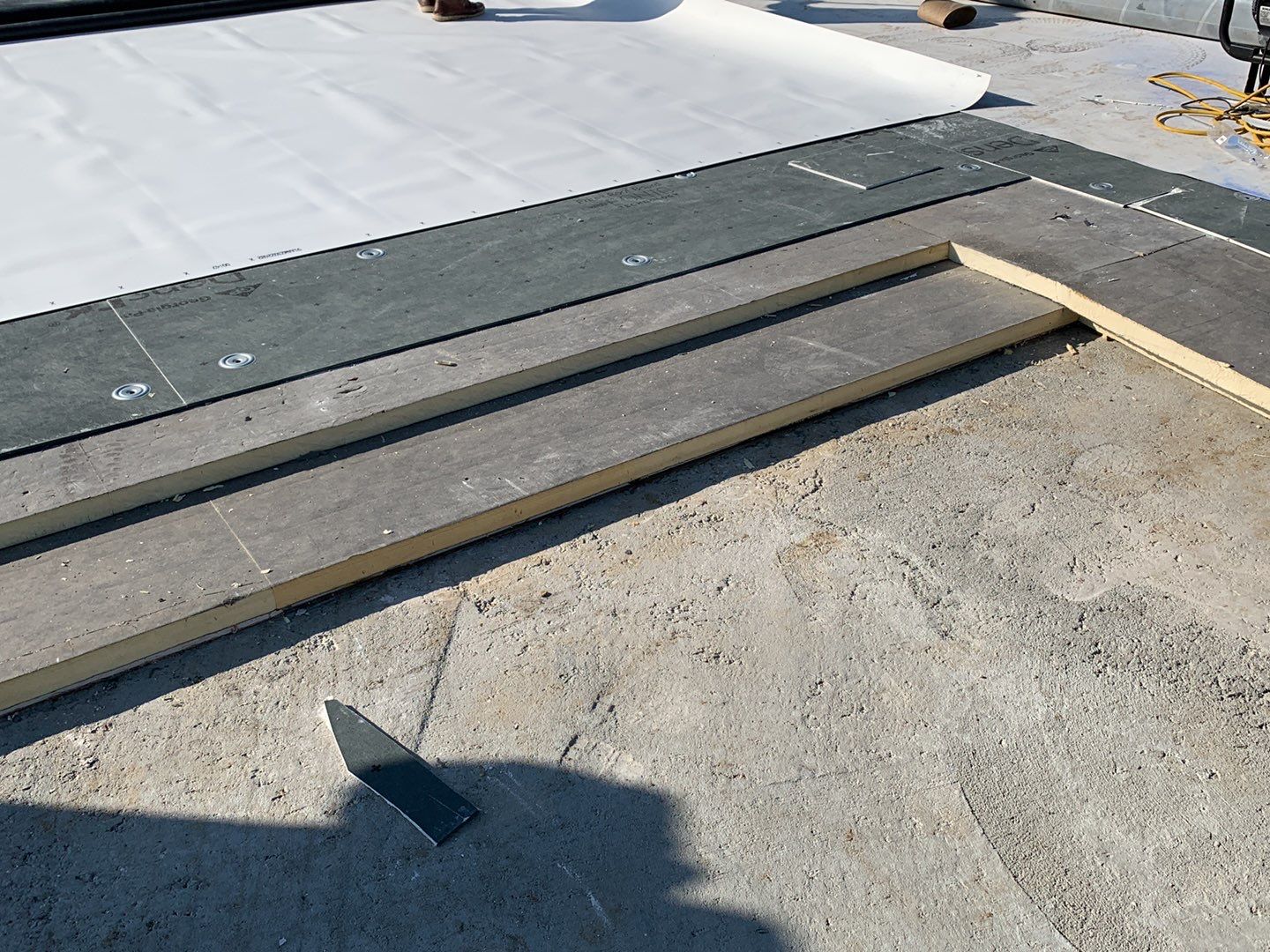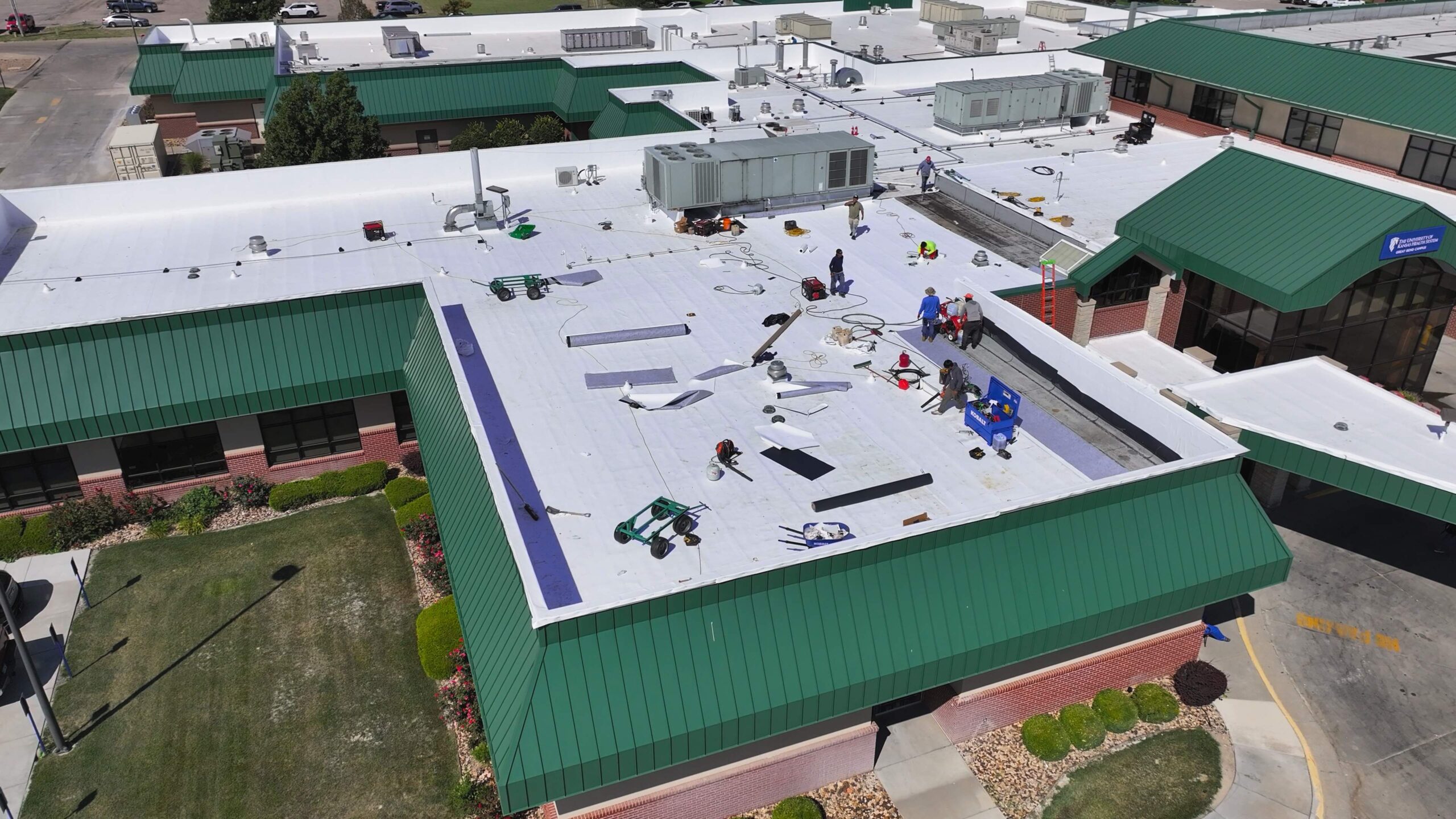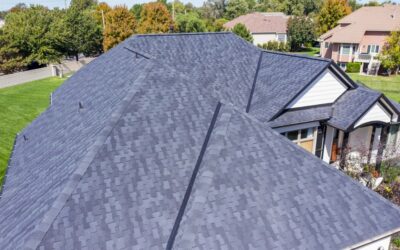When does replacing a low slope roofing membrane, instead of just covering it up, make the most sense? Sometimes a flat roof (aka, low-slope roof) membrane can be covered with another layer when the original layer begins to fail, a process known as a layover. Other times a full remove-and-replace project is the best option. What factors go into making that decisions
When the time comes for a roof replacement versus a layover, often the decision comes down to cost, the effect the installation will have on business activities, and the design of the roof structure.
Layovers are faster and less expensive than the remove-and-replace option, but the benefits are also limited. Any flat roof is eligible for a remove-and-replace project but certain considerations are required to install a layover.
The goal is to make it easier for you to visually inspect your roof and help determine which option will provide the most benefit in your situation. This way you can ask better questions when working with an insurance inspector, contractor, or other roofing professional.
What Is a Flat Roof Layover?
A procedure known as a layover occurs when the existing roof in need of repair is simply covered by another membrane, as opposed to making spot repairs, or removing the old roof completely. A layover can be a good option in some situations, such as when roofing a hospital, where a disruption in the use of the building is not feasible.
Layovers can be done quickly and are an effective way to update the roof and add years of useful life, but there are limitations. Layovers are not always an option due to a number of factors, including:
- The structural stability of the roof. Roofing materials are very heavy, so there is a limit to the amount of weight a roof framework can support.
- Layovers cannot be installed over mechanically connected membranes unless a cover board is added. Cover boards reestablish the flatness of the roof, while adding an additional layer of leak protection.
- Layovers are usually limited to two total roofs, but only where standard building codes are in force.
How Does a Remove-and-Replace Roof Project Work?
In a remove-and-replace flat roofing project the old roof, usually along with the underlayment, is completely removed. This option has the most flexibility, as the roof decking and rafters/trusses can be exposed for repairs. Remove-and-replace roofing projects are also usually warranted fully, while layover warranties can be subject to the performance of the underlying roof.
In a remove-and replace flat roof project the old roof is removed using the appropriate method, such as removing mechanical fasteners and dissolving adhesives. Heat is also an option in some circumstances.
Before the new roof membrane is applied the existing roof deck is inspected and repaired as needed, and a new underlayment is installed in most cases. Sometimes the roof design will use tapered roofing panels, which establish the slope of the roof, insulate, and include the roof decking, all at the same time.
What Is the Difference Between a Fully-adhered Roof and a Partially Adhered Roof?
Some flat roof membranes are fully attached, meaning that the entire surface of the membrane is adhered to the underlying roof decking. Others are partially adhered, meaning the membrane is allowed to lie flat on the roof deck, and is only adhered around the perimeter and any obstacles. Notably, related to removal or layover, they are treated differently based on compatibility of adhesives or how much labor is involved to remove the membrane.
Fully adhered roof membranes have the advantage of resisting punctures, since the membrane is essentially self-sealing. Partially adhered membranes have the advantage of quick replacement, so both can be good options depending on the circumstances.
When Is a Layover Flat Roof a Better Choice?
A flat roof layover can be a time and money saving option versus a remove-and-replace project. Here are a few instances where a flat roof layover offers additional benefits compared to a remove-and replace:
- The roof framework, decking, insulation, and underlayment are still in good condition.
- The roof only has one membrane installed.
- The project budget is limited.
- A disruption in business activity is to be avoided.
- There is no existing water damage or moisture penetration. Just like adding a second diaper over a wet one won’t solve the problem, trapping moisture into a damaged roofing system will exacerbate the problem.
When Is a Remove-and-Replace Flat Roof a Better Choice?
Remove-and-replace flat roof projects solve several problems at the same time. Remove-and-replace projects provide access to the roof deck, allow for upgrades, include a warranty, and provide years of trouble free service.
Unfortunately, complete replacement projects are more expensive, longer, and more disruptive. If any of the criteria listed above are not met, you’ll probably have to do a complete replacement rather than get away with a layover.
Here’s a few examples of situations that may benefit more (or when you’ll be required to) perform a complete remove-and-replace project versus a layover:
- The roof framework, structure underlayment, or insulation requires repairs.
- The project budget can support a 10%-15% upcharge.
- The roof membrane will change from one style (like EPDM, TPO, PVC, Modified Bitumen, etc.) to another. Metal roofing flute-fill retrofit is an exception. See our article on flute-fill retrofits.
- The roof in question already has multiple layers. A core sample can be taken to evaluate existing roof system layers. Building codes often dictate appropriate roofing layers; for example, Sedgwick County (Kansas) building code allows for only two layers of roofing maximum.
- The roof pitch or watershed plan is incorrect, requiring the addition of fiberboard, DensDeck, or tapered insulation panels.

The campus of this large K-8 school facility was experiencing roofing problems for years, and required more extensive construction. Timing was not a restriction, as work could be performed over the summer when school was not in session. This is a complete remove-and-replace of all layers down to decking (layers shown in the picture) and work was performed in 3 phases over 3 summers to spread out the capital expenditure and building interruption. A creative solution to fit the needs of this building and make for leak-free classrooms for many years to come.

The number one priority for this regional hospital and trauma center was limiting building downtime and any interruption to patient care. Adding extra pressure to the roofing timeline, the presence of a rooftop helipad remained active during construction. In this case, a full layover provided adequate weather-sealing to address the storm-damaged roof while keeping the project as fast as possible.
Which Is Better: A Flat Roof Layover or a Remove-and-Replace Flat Roof?
The decision to remove-and-replace, or install a layover membrane, should consider all the elements of the project. If your roof meets the criteria where both are appropriate options, here are some of the questions we typically get from customers or that we would ask them to evaluate which might be the best decision for them:
- Will the owner still own the building in 10 years when a new membrane will likely be needed again? Will making a voluntary capital investment in the roof provide a significant return when the building changes ownership?
- Will the roof add measurable value to the building? Even though a roof is not an optional expense the overall cost can be reduced to maximize the return on the investment.
- Will the activity of the business inside the structure be impacted by the roofing project? Will the tenant need to cease operations during the project? What cost will the shutdown have on the tenant?
- Will the use of the building change in the foreseeable future? Some structures, like hospitals, often require a specific membrane that is unaffected by contaminants, like oil and grease. Installing an inappropriate membrane for the use of the building could cause more problems than it solves.
What Additional Steps Can Help Make A Decision about Layover vs Remove-and-Replace on a Flat Roof?
Having a core sample cut into your roof, usually performed by a professional and then patched on site, can tell you about the composition of each layer of your existing flat roof system. From there, specific product compatibility and cost figures can be assigned to the different options available. Here at Rhoden Roofing, we offer free inspections, and our team can help talk through various options and how other business owners in similar situations have worked toward making the decision that fits their needs. To connect with our team for a free inspection, you can follow this link.



